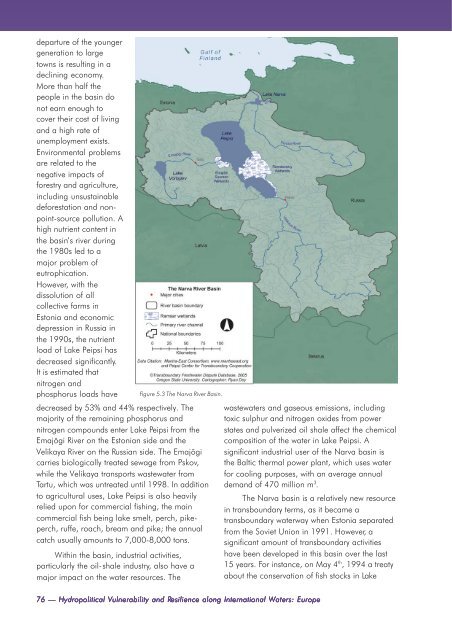Europe - UNEP
Europe - UNEP
Europe - UNEP
Create successful ePaper yourself
Turn your PDF publications into a flip-book with our unique Google optimized e-Paper software.
departure of the younger<br />
generation to large<br />
towns is resulting in a<br />
declining economy.<br />
More than half the<br />
people in the basin do<br />
not earn enough to<br />
cover their cost of living<br />
and a high rate of<br />
unemployment exists.<br />
Environmental problems<br />
are related to the<br />
negative impacts of<br />
forestry and agriculture,<br />
including unsustainable<br />
deforestation and nonpoint-source<br />
pollution. A<br />
high nutrient content in<br />
the basin’s river during<br />
the 1980s led to a<br />
major problem of<br />
eutrophication.<br />
However, with the<br />
dissolution of all<br />
collective farms in<br />
Estonia and economic<br />
depression in Russia in<br />
the 1990s, the nutrient<br />
load of Lake Peipsi has<br />
decreased significantly.<br />
It is estimated that<br />
nitrogen and<br />
phosphorus loads have<br />
decreased by 53% and 44% respectively. The<br />
majority of the remaining phosphorus and<br />
nitrogen compounds enter Lake Peipsi from the<br />
Emajõgi River on the Estonian side and the<br />
Velikaya River on the Russian side. The Emajõgi<br />
carries biologically treated sewage from Pskov,<br />
while the Velikaya transports wastewater from<br />
Tartu, which was untreated until 1998. In addition<br />
to agricultural uses, Lake Peipsi is also heavily<br />
relied upon for commercial fishing, the main<br />
commercial fish being lake smelt, perch, pikeperch,<br />
ruffe, roach, bream and pike; the annual<br />
catch usually amounts to 7,000-8,000 tons.<br />
Figure 5.3 The Narva River Basin.<br />
Within the basin, industrial activities,<br />
particularly the oil-shale industry, also have a<br />
major impact on the water resources. The<br />
wastewaters and gaseous emissions, including<br />
toxic sulphur and nitrogen oxides from power<br />
states and pulverized oil shale affect the chemical<br />
composition of the water in Lake Peipsi. A<br />
significant industrial user of the Narva basin is<br />
the Baltic thermal power plant, which uses water<br />
for cooling purposes, with an average annual<br />
demand of 470 million m 3 .<br />
The Narva basin is a relatively new resource<br />
in transboundary terms, as it became a<br />
transboundary waterway when Estonia separated<br />
from the Soviet Union in 1991. However, a<br />
significant amount of transboundary activities<br />
have been developed in this basin over the last<br />
15 years. For instance, on May 4 th , 1994 a treaty<br />
about the conservation of fish stocks in Lake<br />
76 — Hydropolitical Vulnerability and Resilience along International Waters: <strong>Europe</strong>
















